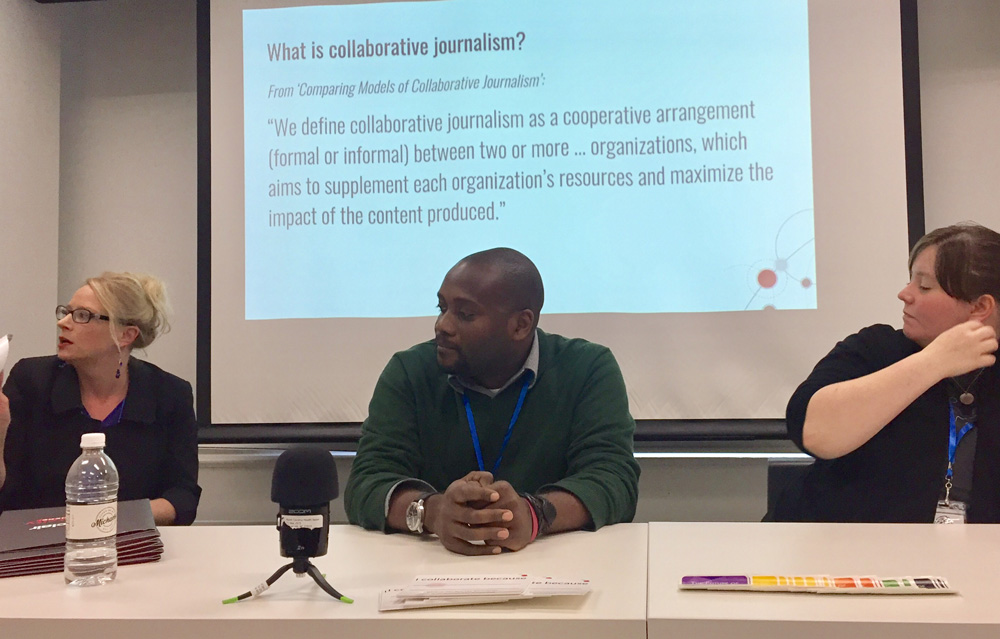Collaboration Can Be a Win-Win for News Sites
In an era when journalists are often stretched thin, collaborative arrangements – formal or informal – may be the best

By Ronni Newton, We-Ha.com
In an era when journalists are often stretched thin, collaborative arrangements – formal or informal – may be the best way to increase reach, diversity, influence, and credibility, said a panel of experts who spoke at the 2017 LION Summit on Friday.
Stefanie Murray of the Center for Cooperative Media and John S. Knight Fellows Heather Bryant and Andre Natta shared the results of their research as well as actual and varied experiences with collaborative efforts. They include collaborations between local news sites and national organizations, and between non-profits and commercial organizations.
“Working together in the public’s interest, rather than only independently in our own interest, is a different way of looking at competition.” Murray said. Collaborative efforts can work through a variety of models, and be utilized for specific projects or on an ongoing basis.
Bryant said collaborations may start informally, like sharing photos from a game or other event with another news outlet.
“I’ve found a lot of people are already doing it – especially now that we’re all broke,” Bryant said.
Through Project Facet, Bryant is working to address infrastructure/technlology conflicts that arise during collaborations, determine how to overcome logistics and managerial issues. The positives of collaboration include expanding resources, diversity, expertise, reach, access, power and influence, credibility and trust, and audience attention, she said.
“A lot of newsrooms looking at collaboration a way to get more money,” Natta said, but there are other best practices in place locally.
Murray has coordinated several collaborative projects in New Jersey, and has awarded six grants of $7,000 each to support collaborations.
Several examples of collaborative efforts described during Friday’s session included
• Documenting Hate: A ProPublica-led effort to collect information about local hate crimes and help local news organizations tell those stories. Their list of partners has been growing.
• Small towns, big change: A Solutions Journalism Network-coordinated effort in Colorado and New Mexico involving seven news organizations examining long-term threats to small towns in an under-covered region of the country.
• Voting Block: An ongoing New Jersey-based collaboration focusing on governor’s race, involving 25 news organizations, with goals that include creating more civil political dialogue and sparking interest in the governor’s race. Grants were obtained to support the work of small news organizations, 15 hyperlocal and six ethnic operations, that have enlisted neighbors to participate in a recorded discussion about politics. Project managers will continue to follow up with the neighbors until the November election.
• SCATV and Scout Magazine: Two organizations that joined forces to create multi-platform stories in one of New England’s most densely populated communities. Both located in Somerville, Mass., the collaboration began casually over beers as a means of combining storytelling and video expertise.
The biggest problems, Murray said, are technology and “not having someone to herd the cats.” Failure to measure or work toward a goal can also be impediments to success.
Natta said that some of the best collaborations are not financially motivated. “It’s really about impact and the way to get more exposure.”
Also critical, Murray said, is trust between collaborators.
Resources provided by Bryant include:
• Collaborative news slack: bit.ly/collaborativeslack
• bit.ly/ona17collabnotes
• bit.ly/collabj
Ronni Newton is a partner with We-Ha.com.
Sign up for the weekly newsletter
Join the LION mailing list to get our weekly roundup of opportunities and resources for news entrepreneurs. View our most recent issues.
Related Articles
How five LION members are maximizing revenue and community engagement through events
Whether you’re a solopreneur or part of a larger team, there are in-person event opportunities for everyone.
Jess deRivera joins LION Publishers as our Membership Services Manager
She’ll help provide a seamless experience to current and prospective members.
Four big opportunities that local news publishers can pursue right now
Here’s how to capitalize on each one.
